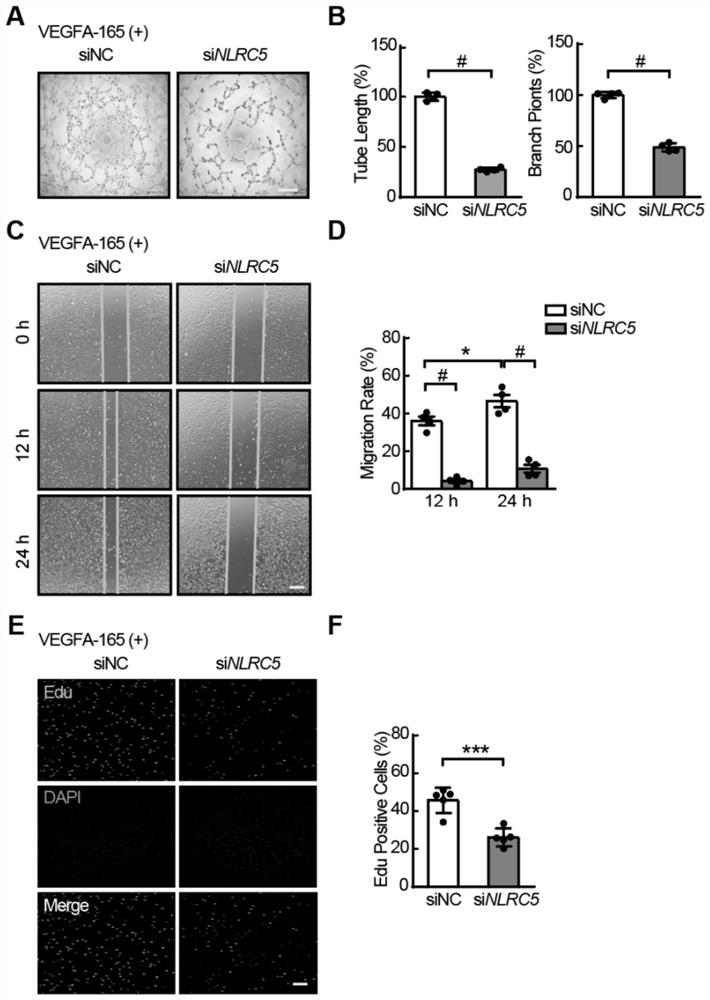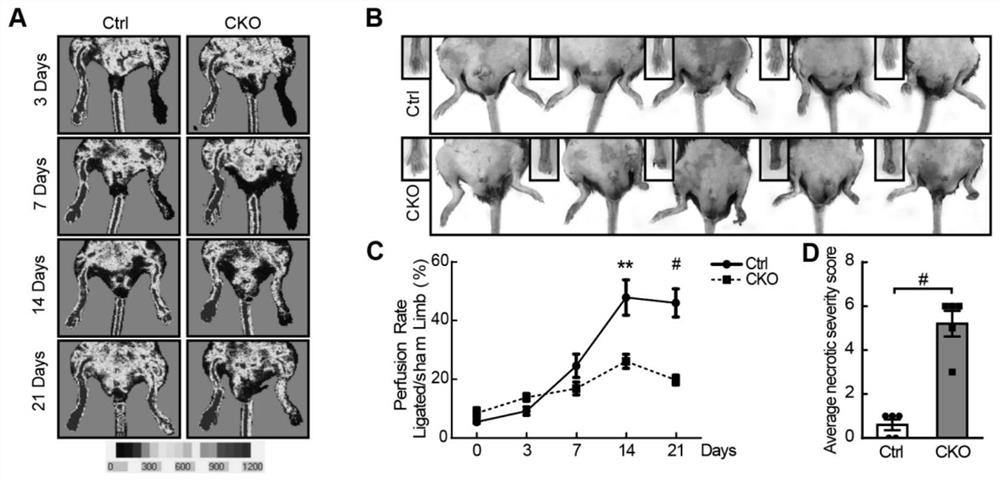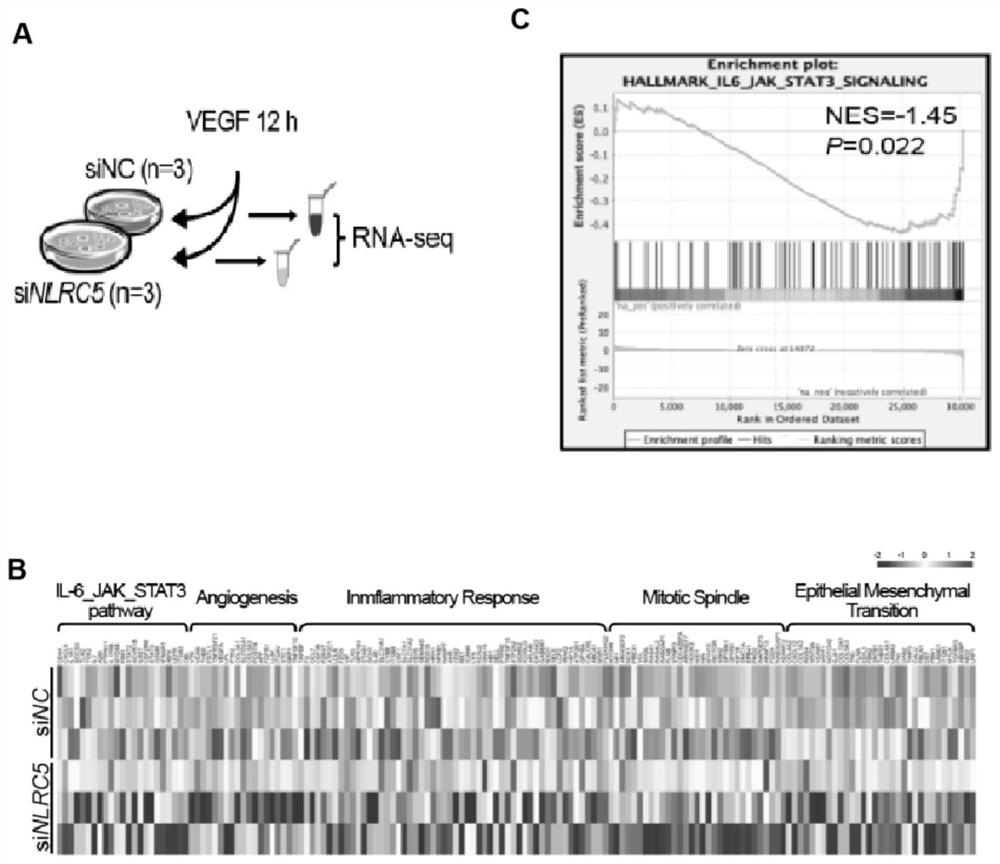Polypeptide for promoting angiogenesis and pharmaceutical use of polypeptide
An angiogenesis and drug technology, applied in the field of biomedicine, can solve problems such as ischemic diseases that have not been reported yet
- Summary
- Abstract
- Description
- Claims
- Application Information
AI Technical Summary
Problems solved by technology
Method used
Image
Examples
Embodiment 1
[0040]Example 1: NLRC5 Knockdown and Cell Function Detection in HUVEC
[0041] 1. NLRC5 knockdown in HUVEC: first put HUVEC into a 6-well plate, and when the confluence of the cells reaches 70%, transfect with siRNA (small interfering RNA, small interfering RNA). Use Lipofectamine 2000 (Cat#11668027, Invitrogen) liposomes for siRNA transfection, according to the product operation manual, transfect HUVEC with negative control siRNA and NLRC5 siRNA (SASI_Hs02_00359503, Sigma) at a concentration of 50 nM, and perform subsequent experiments after 48 hours of transfection .
[0042] 2. HUVEC function testing includes: tube formation, migration, proliferation ability testing:
[0043] (1) Tube formation: Add 50 μl of melted Matrigel matrigel to the pre-cooled 96-well cell culture plate, put it in the incubator for 30 minutes and solidify, spread the treated HUVEC into the 96-well plate at a density of 20,000 / well , and VEGFA-165 (50ng / ml) was added, placed in the incubator for 6-8...
Embodiment 2
[0047] Example 2: Establishment of mouse lower limb ischemia model, blood perfusion detection and lower limb ischemia score
[0048] 1. Establishment of lower limb ischemia model: 5 C57BL / 6J WT mice aged 8-10 weeks and 5 endothelial cell NLRC5-specific knockout mice were anesthetized with 2% isoflurane, and the skin was cut open. The femoral artery was separated and ligated to avoid damage to the nerve and vein, and the skin was sutured and sterilized.
[0049] 2. Lower limb blood perfusion detection: mice were anesthetized with 2% isoflurane, and lower limb blood perfusion was detected using a Doppler blood flow detector (moorLDILaser Doppler Perfusion Imager, England), and blood perfusion rate = ligated side blood flow Perfusion volume / contralateral sham operation blood perfusion volume. Mouse lower limb ischemia score: 28 days after ligation, the mouse lower limb ischemia score was scored, and the scoring rules were as follows: 0 points = no necrosis, 1 point = 1-3 toe tip...
Embodiment 3
[0051] Example 3: RNA sequencing and GSEA analysis after HUVEC knockdown of NLRC5
[0052] RNA-seq: After knocking down NLRC5 in HUVEC according to the steps in Example 1, stimulate VEGF (50ng / ml) for 12h, collect cellular RNA with Trizol, and use the Illumina TruSeq RNA Sample Prep Kit kit (Cat#FC-122- 1001) to build a library, then use the novaseq6000 platform for RNA sequencing, and finally use DESeq to screen differently expressed genes. GSEA analysis: according to the log of two groups of genes 2 Fold Change constructs RNK files, uses GSEA 4.1.0 version for analysis, and further screens according to p<0.05 and q<0.25.
[0053] The experimental flow and result figure of above-mentioned embodiment are as follows image 3 As shown, it was demonstrated that NLRC5 binds to STAT3 as a scaffolding protein. Among them, A is the experimental flow chart, B is the RNA sequencing map, and C is the GSEA analysis map. RNA sequencing was performed after knockdown of NLRC5 in HUVEC. ...
PUM
| Property | Measurement | Unit |
|---|---|---|
| Molecular weight | aaaaa | aaaaa |
Abstract
Description
Claims
Application Information
 Login to View More
Login to View More - R&D
- Intellectual Property
- Life Sciences
- Materials
- Tech Scout
- Unparalleled Data Quality
- Higher Quality Content
- 60% Fewer Hallucinations
Browse by: Latest US Patents, China's latest patents, Technical Efficacy Thesaurus, Application Domain, Technology Topic, Popular Technical Reports.
© 2025 PatSnap. All rights reserved.Legal|Privacy policy|Modern Slavery Act Transparency Statement|Sitemap|About US| Contact US: help@patsnap.com



